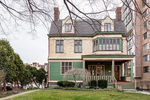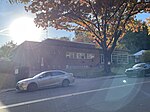The Electric Banana
The Electric Banana was a nightclub in Pittsburgh, Pennsylvania. Beginning as a disco in the 1970s, it was a punk rock music venue from 1980 until 2000, and helped establish a place in alternative culture for the city of Pittsburgh.The venue hosted such acts as Black Flag, Circle Jerks, The Misfits, Hüsker Dü, Sonny Vincent and the Extreme, Half-Life, Dead Milkmen, Meat Puppets, Descendents, Rhythm Pigs, Snakefinger, Wreckless Eric, Ian Dury, Sepultura, Candlemass, Morbid Angel, New Model Army, They Might Be Giants, Minutemen, Jimmy’s Rose Farm, and countless others. Located at 3887 Bigelow Boulevard, it was transformed by owner Johnny "Banana" Zarra into an Italian restaurant called "Zarra's: A Taste Of Southern Italy."
Excerpt from the Wikipedia article The Electric Banana (License: CC BY-SA 3.0, Authors).The Electric Banana
North Craig Street, Pittsburgh
Geographical coordinates (GPS) Address Nearby Places Show on map
Geographical coordinates (GPS)
| Latitude | Longitude |
|---|---|
| N 40.4548 ° | E -79.9542 ° |
Address
North Craig Street 471
15213 Pittsburgh
Pennsylvania, United States
Open on Google Maps








